Plant spinach in cool weather. It is well suited for the spring and autumn gardens.
Plant spinach before the weather warms in spring and again as the weather cools in early autumn. (When days lengthen in late spring and the weather becomes dry and hot, spinach bolts and stops making new leaves.)
Spinach can be planted in soil as chilly as 35ºF (2ºC). Sow spinach seeds in the garden 4 to 6 weeks before the last spring frost date.
Spinach is a fast crop and can be harvested in 35 to 50 days, so is well-suited for planting and harvest in the cool weather of early fall as well.
Related articles:
- Six Ways to Cook and Serve Spinach
- Spinach Seed Starting Tips
- How to Harvest and Store Spinach
- Spinach Growing Problems Troubleshooting
- How to Plant and Grow Spinach
- How to Grow New Zealand Spinach
- How to Grow Malabar Spinach
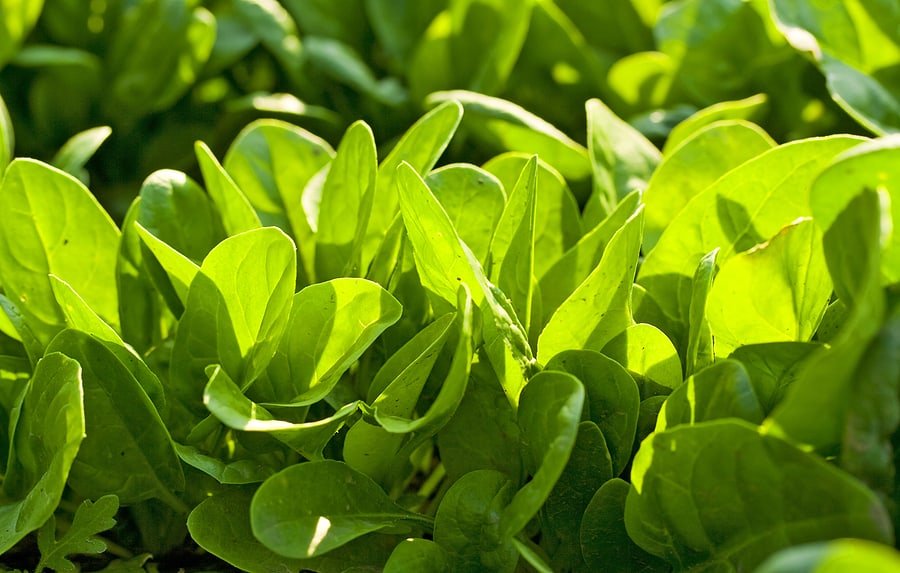
Spinach can be grown under cover in cold weather. Plant spinach in early fall then cover plants with a plastic tunnel or set plants in a cold frame for a harvest of fresh spinach, both tender leaves cut and come again or the entire plant in winter. Where winters are mild, spinach can be harvested without cover from October to April–and that is the time of year when it is not bothered by insects and diseases.
Spinach is a great-tasting early-season green. Next to the dandelion is the first green that can be harvested in early spring. It is also one of the best fall and winter crops.
Where to grow spinach
Spinach grows well in full sun in cool regions or partial shade in warm regions. Spinach is hardy and will withstand moderate frost.
Spinach prefers moist, humus-rich, fertile soil, thoroughly worked with plenty of organic matter added. Light sandy soils with good drainage are best in regions of high rainfall.
- Grow spinach in full sun in spring and autumn in most regions. Grow spinach in partial shade in warm regions.
- Plant spinach in loamy soil rich in organic matter. Adding aged compost to the soil should ensure good drainage. Add two inches of aged compost or a commercial organic planting mix to the planting beds before planting then turn the soil to 12 inches (30cm) deep.
- Sow spinach in light soil that is well-drained.
- Prepare planting beds by working plenty of aged compost to a depth of 4 inches; remove clumps of soil or organic matter before sowing.
- Add blood meal–rich in nitrogen–to the planting bed to promote rapid growth.
- Spinach grows more quickly in sandy soil and more slowly in clay soil.
- Spinach prefers a soil pH of 6.0 to 6.8. Spinach does not grow well in alkaline soil.
- Spinach is hardy and thrives in cool weather; ideal spinach-growing weather is 50°F to 70°F (10-21°C).
- Warm weather and long days will cause spinach to bolt—that is it will flower and go to seed.
- Mulch plants to cool the soil in warm regions.
Good Products for Growing Spinach at Amazon:
- Garden Safe Snail and Slug Bait
- Bonide Sulfur Fungicide
- Monterey BT Caterpillar Killer
- Neem Bliss 100-% Cold Pressed Neem Oil
- Safer Brand Insect Killing Soap
- PyGanic Botanical Insecticide
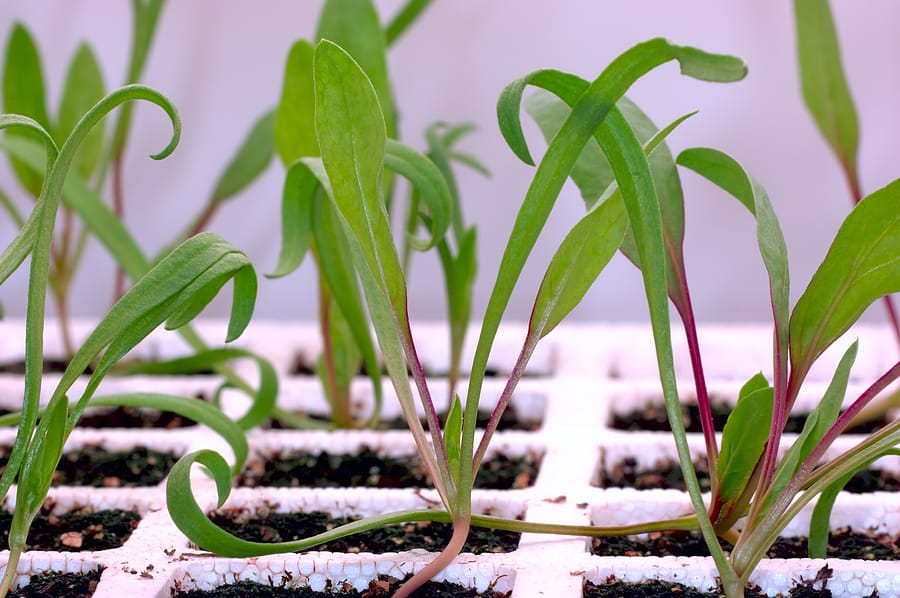
When to plant spinach
Spinach is a cool-weather crop that grows best when the daytime temperature remains consistently below 75°F–commonly in spring or fall.
Young plants will bolt when exposed to temperatures below 40°F, but mature plants can withstand temperatures as low as 20°F.
- Spinach is a cool-season annual. It needs 6 weeks of cool weather from seed sowing to harvest.
- Spinach grows best when planted outdoors in early spring and then again in autumn. In mild-winter regions grow spinach outdoors in winter.
- Sow spinach seeds directly in the garden as soon as the soil temperature reaches 35°F and the ground is workable.
- Direct sow spinach outdoors or set out transplants 4 weeks before the last average frost date.
- Sow spinach indoors 6 to 8 weeks before the last average frost date in spring for transplanting out as early as 4 weeks before the last frost. However, seedlings may suffer transplant shock if the roots are disturbed at transplant time.
- Plant succession crops of spinach in spring every 10 to 14 days until daytime temperatures are consistently greater than 75°F. Succession planting will ensure a continual harvest of fresh spinach leaves.
- Long days and temperatures greater than 75°F encourage mature spinach plants to bolt.
- Young plants may bolt if exposed to temperatures below 40°F for one or two weeks after they come up.
- In mild-winter regions, plant spinach in late summer or early autumn for harvest in autumn or winter; sow spinach for autumn harvest 6 to 8 weeks before the first fall frost.
- Spinach can be grown through the winter everywhere in a cold frame or plastic tunnel.
- Spinach planted in autumn can survive the winter under thick mulch; plants will resume growing in the spring. The best alternative is to grow winter spinach in a cold frame or plastic tunnel.
- Temperatures of 20°F or below can freeze leaves and kill plants.
- Don’t grow spinach through the summer in hot summer regions. Instead, grow New Zealand spinach or Malabar spinach which are heat tolerant.
- Spinach grows best when temperatures range between 60°F and 65°F. Spinach is an excellent choice for fall gardens since mature plants can withstand frost.
- Sow spinach about 8 weeks before the first expected frost.
- Mature spinach leaves will not freeze until temperatures hit 20°F.
- Overwinter spinach by covering plants with 8 to 12 inches of straw, or grow spinach through the winter in a cold frame.
- In spring, plant spinach early to harvest before temperatures climb; increasing day length can also cause spring spinach to bolt.
- In warm climates, plant spinach in the shade of tall or trellis-grown crops such as corn, squash, beans, or peas to help prevent bolting.
- Protect plants with shade cloth if the temperature goes above 80°F; mulch in the fall to lower the soil temperature.
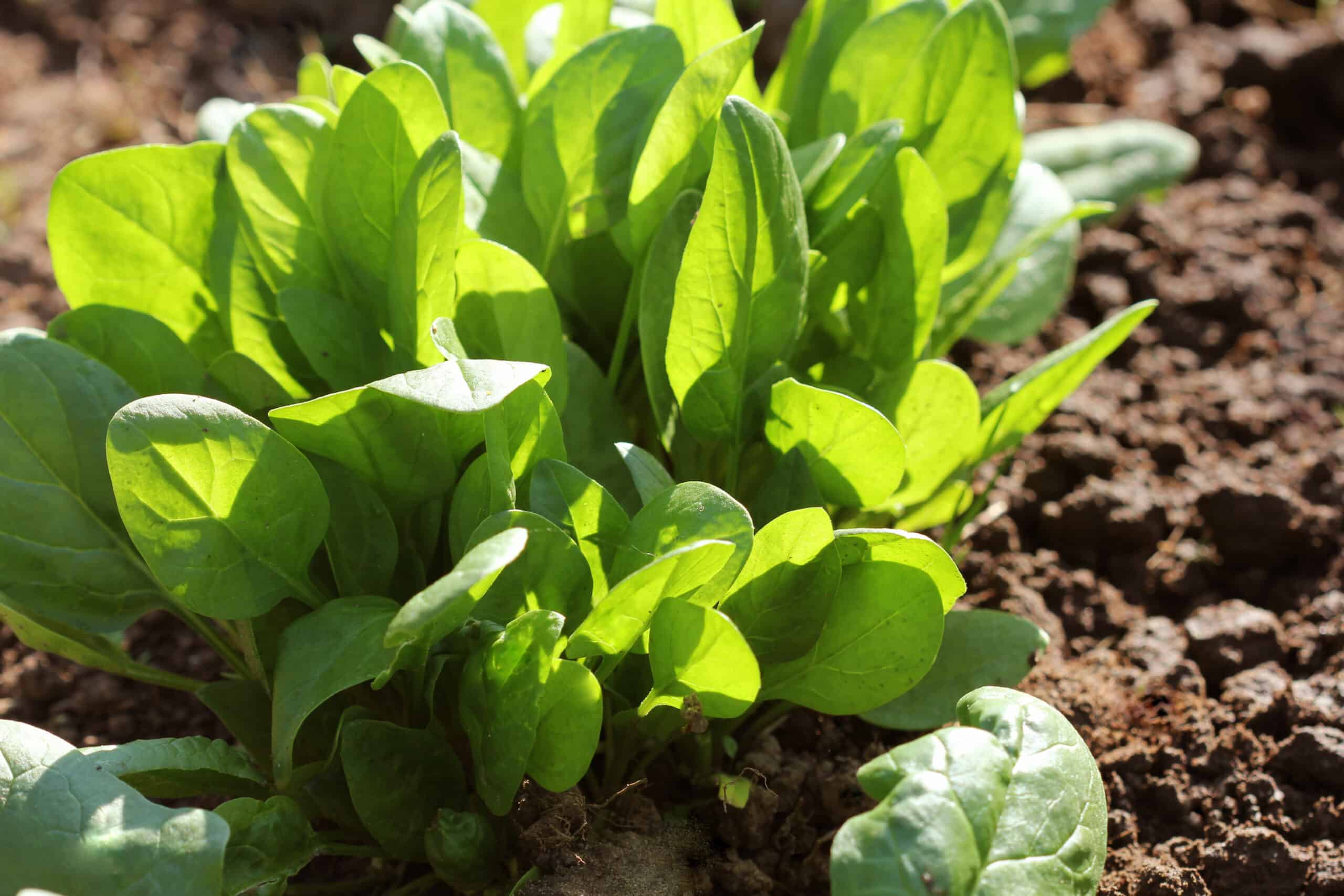
| # | Preview | Product | Price | |
|---|---|---|---|---|
| 1 |

|
365 by Whole Foods Market, Organic Baby Spinach, 5 oz | Buy on Amazon | |
| 2 |

|
Taylor Farms Spinach, 9 oz Bag | Buy on Amazon |
Growing spinach as a winter crop
- Grow spinach through the winter under a cold frame, row covers over hoops or straw mulch.
- Sow seed 6 weeks before the first expected frost so that plants get up to size before frost or freezing temperatures come.
- Sow winter crops in raised beds to ensure quick drainage.
- Choose hardy varieties for winter growing. In warm winter regions, grow spinach through the winter without cover.
Planting spinach
Sow spinach seed ¼ inch (6 mm) deep and 2 inches (5 cm) apart. Thin successful plants to 4-6 inches (10-15 cm) apart. Clip small leaves in 3-5 weeks, depending on the time of year and speed of growth.
- Plant spinach seed ½ inch (12mm)deep. Cover the seed lightly with the soil.
- Refrigerate seeds 1 week before sowing to help germination.
- Sow seed 2 to 4 inches (5-10cm) apart.
- Space rows 12 to 14 inches (30-35cm) apart.
- Spinach seed will germinate in 5 to 9 days at 70°F (21°C) Germination will take longer if the soil is cooler, about 21 days at 50°F (10°C).
- Soak spinach seeds in compost tea for 20 minutes before sowing to speed germination.
- In warm weather, place spinach seeds in the freezer for two days then moisten and refrigerate them for two more days before sowing.
- The optimal temperature for germination is 70°F; spinach seeds will germinate more slowly at temperatures as low as 35°F.
- Spinach will not germinate in soil temperatures greater than 85°F. Sow spinach seed ¼ inch deep and 1 inch apart; thin plants to 6 inches apart when seedlings are 1 to 3 inches tall.
- Spinach can be grown in intensive beds (to help retain moisture), or space rows 1 to 3 feet apart.
- Plant about 30 plants for each person in the household.
- Thinnings can be added to salads.
- Succession cropping. Sow spinach every 10 to 14 days to ensure a steady harvest of tender young leaves; the harvest of one plant extends over two to six weeks. Spinach is ready for harvest in about 40 days.
- Thin spinach to 12 inches (30cm) apart when seedlings are 3 inches (7cm). Thin to the strongest seedlings. Remove weak seedlings by cutting them off at the soil level with scissors.
- Thin spinach so that there is good air circulation between mature plants.
- Grow 15 plants per household member.
More tips: Spinach Seed Starting Tips.
Container growing spinach
- Spinach will grow in a container. Allow one plant for each 8-inch (20cm)pot; in large containers plant spinach in 10-inch (25cm) centers.
- If you plan to harvest young leaves or young plants, you can grow 4 plants in a 12-inch pot. To harvest mature leaves, grow fewer plants in a pot.
- Spinach is heat-sensitive; move containers into the shade on warm and hot days.
- Containers will warm more quickly than garden soil in spring.
Companion plants for spinach
Plant spinach with beans, members of the cabbage family, celery, legumes, lettuce, onions, peas, radishes, and strawberries. Plant successive crops of spinach every 2-3 weeks in early spring until the temperatures rise above 65°F (18ºC) and the days lengthen.
- Grow spinach with other greens.
- Spinach is a good companion in the shadows of tall crops such as corn, pole beans, or other members of the amaranth family such as beets and Swiss chard.
Watering spinach
Keep the soil moist, without wetting spinach leaves, unless the plant will dry quickly before nightfall.
- Keep the soil evenly moist throughout the growing season to grow spinach quickly.
- Water spinach at the base of the plant. The base of plant watering will avoid splashing muddy water onto leaves.
- Spinach grows best in evenly moist but not wet soil. Water spinach every other day in light sandy soil; water once a week in heavy soil.
- Consistent moisture will ensure rapid growth and prevent bolting. In warm regions, mulch around plants to slow soil moisture evaporation.
- Where soil is slow draining, plant spinach in raised beds.
- Mulch around spinach plants with straw, chopped leaves, or garden compost to prevent soil moisture evaporation and avoid splashing soil on leaves.
Feeding spinach
Prepare the soil with plenty of organic matter. Apply fish emulsion or 1 tablespoon (15 ml) of blood meal mixed in 1 gallon (4.5 liters) of water every 3 or 4 weeks.
- Spinach is a heavy feeder. Feed spinach with compost tea, manure tea, or fish emulsion when plants have four true leaves.
- Mix 1 tablespoon of fish emulsion and 2 tablespoons of kelp extract per gallon of water; use about one cup per one foot of row on a weekly basis until plants are about 4 inches tall; then feed two more times before harvest.
- Side dress plants with compost tea or a dilute solution of fish emulsion every two weeks during the growing season.
- Side-dress spinach with aged compost at midseason.
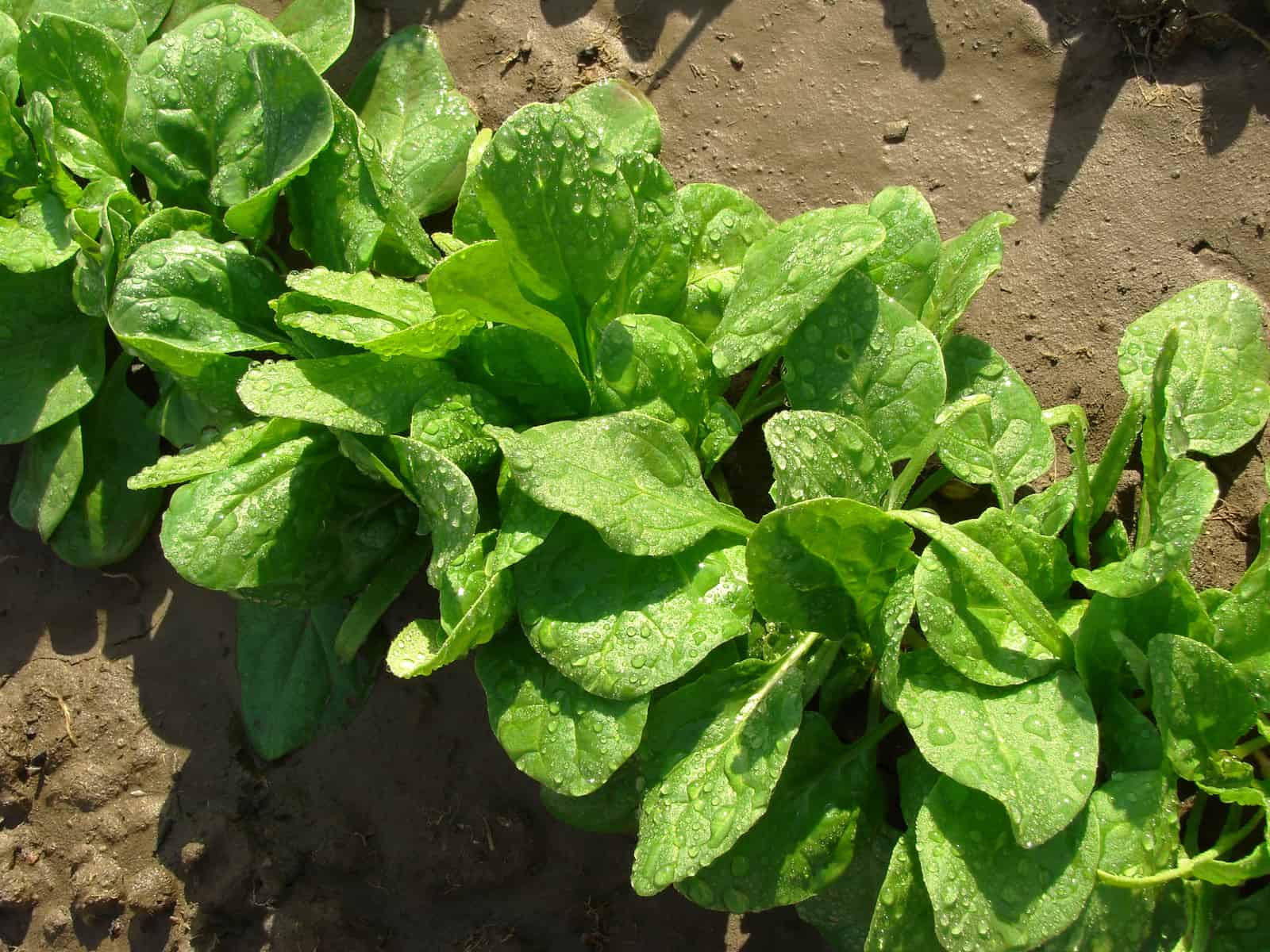
Caring for spinach
- Keep planting beds free of weeds to avoid competition for light, water, and nutrients.
- Cut weeds at soil level rather than digging them out; spinach has a deep taproot but shallow feeder roots that can be injured easily.
- Mature spinach plants can tolerate temperatures as cold as 20°F (-6.7°C), but it is best to protect plants from freezing weather by covering the bed with a portable plastic tunnel or row cover.
- Spinach will bolt in temperatures greater than 75°F (24°C). If the weather warms, try protecting spinach under a shade cloth set over a frame.
Spinach season extension
- Plant spinach in a cold frame in late winter (February), and the crop will be ready in early spring.
- Choose heat- and bolt-resistant cultivars.
- Grow spinach in the light shade when the weather warms; plants in containers can be easily moved from a sunny location into a cooler, shady location.
- Plant hardy cultivars for fall and winter harvest (check seed packets for hardiness).
- Overwinter spinach plants by covering them with 8 to 12 inches of straw; when daytime temperatures reach 50° to 60°F in spring, gradually remove a few inches of straw each week.
- In warm winter regions, plant spinach in fall as a winter crop.
Spinach problems
- Bolting. Spinach will bolt (form flowering stalks and go to seed) in warm temperatures and increasing day length. If a central stalk starts to form but temperatures have not started to warm, cut the whole plant back to just above the soil line and let the leaves regrow.
Spinach pests
Hand remove snails and slugs that attack spinach, and spray away aphids with a steady stream of water.
Leaf miner larvae tunnel through spinach leaves and leave a trail of light-colored squiggles or blotches. Pick and destroy this foliage; keep the garden clean of leaf debris. Protect young spinach plants from leaf miners, flea beetles, and aphids with row covers as long as temperatures are moderate. Row covers can be removed in chilly weather. After harvest, turn the planting bed to destroy larvae in the soil.
- Spinach can be attacked by aphids, flea beetles, leaf miners, slugs, and spider mites.
- Knock aphids off plants with a strong blast of water. Pinch out heavily-infested foliage.
- Remove leaves in which leafminers are tunneling-. Look for the eggs on the underside of the leaves. Floating row covers can exclude leafminer flies from the planting bed.
- Spray flea beetles and spider mites with spinosad.
- Use row cover over young plants to exclude attacks by flea beetles and caterpillars. Row covers can remain in place as long as temperatures are moderate.
- Leafminers can spread quickly; till the soil at the end of the growing season exposes leafminer eggs to winter cold.
- Keep slugs and snails away from spinach by sprinkling a barrier of diatomaceous earth around plants.
More on pests and diseases: Spinach Growing Problems: Troubleshooting.
Spinach diseases
Spinach is susceptible to some soil-borne diseases. Plant disease-resistant varieties.
- Spinach is susceptible to mildew, rust, and mosaic virus.
- Plant rust and disease-resistant varieties.
- Mildew and rust are fungal diseases. Spray-mist leaves with compost tea to prevent fungal diseases.
- Plants hit by mosaic virus should be removed from the garden. The mosaic virus will cause leaves to be mottled or streaked with white or yellow spots.
- Keep the garden clean of debris. Remove and destroy diseased plants.
- Good air movement discourages fungal diseases such as downy mildew, white rust, and anthracnose.
- Hot temperatures encourage Fusarium wilt and other fungal diseases, as well as promote bolting.
- ‘Melody’, ‘Indian Summer’, and other cultivars resist mosaic virus and downy mildew. ‘Fall Green’ is a white rust-tolerant cultivar.

Harvesting spinach
Harvest spinach when leaves are 4-7 inches (10-18 cm) long on heads with 6-8 leaves; thin leaves from the outside to allow central growth bud to continue producing leaves.
Spinach is ready for picking in about 40 days; for a continuous harvest, sow spinach every 14 to 21 days.
- Start harvesting spinach when plants have at least six leaves that are 3 inches long.
- Pick the outside leaves first and the inner leaves will continue to grow or cut the entire plant just below the soil level with a garden knife.
- Cutting outside leaves will extend harvests, particularly with fall and winter crops.
- Baby spinach leaves are tender and tasty.
- Spinach leaves can be harvested as soon as they are big enough to eat.
- Cut leaves 4 to 7 inches (10-17cm) long from plants that have 6 to 8 leaves. Cut the older outer leaves first. Allow the remaining young leaves to grow on to maturity.
- If you harvest all of the leaves from a plant, cut the leaves 3 inches (7cm) above the soil; new leaves will grow on for a second harvest.
- Very large leaves and older leaves can be bitter; harvest leaves sooner rather than later.
- Lengthening days (days longer than 14 hours) and warming weather (temperatures greater than 75°F/24°C) will cause spinach to bolt, flower, and set seed. Bolting will mark the end of the harvest.
Storing and preserving spinach
- Wash spinach thoroughly to eliminate the grit that sometimes sticks to crinkled leaves.
- Spinach can be refrigerated for up to one week.
- Spinach can be frozen canned or dried.
- Spinach seeds can be sprouted.
Spinach in the kitchen
Spinach can be eaten raw or cooked. The dark green leaves of fresh spinach will add color to a lettuce salad. Spinach can be pan-steamed in the water it is rinsed with.
- Spinach can be eaten raw or cooked.
- The dark green leaves of fresh spinach will add color to a lettuce salad.
- Spinach can be pan-steamed in the water it is rinsed with.
- Stir-fry spinach with garlic or bacon grease.
- Bake spinach with alternating layers of pasta and cheese.
- Add spinach to mushroom soup or cream soup.
- Add spinach to omelets and quiche.
More tips: How to Harvest and Store Spinach.
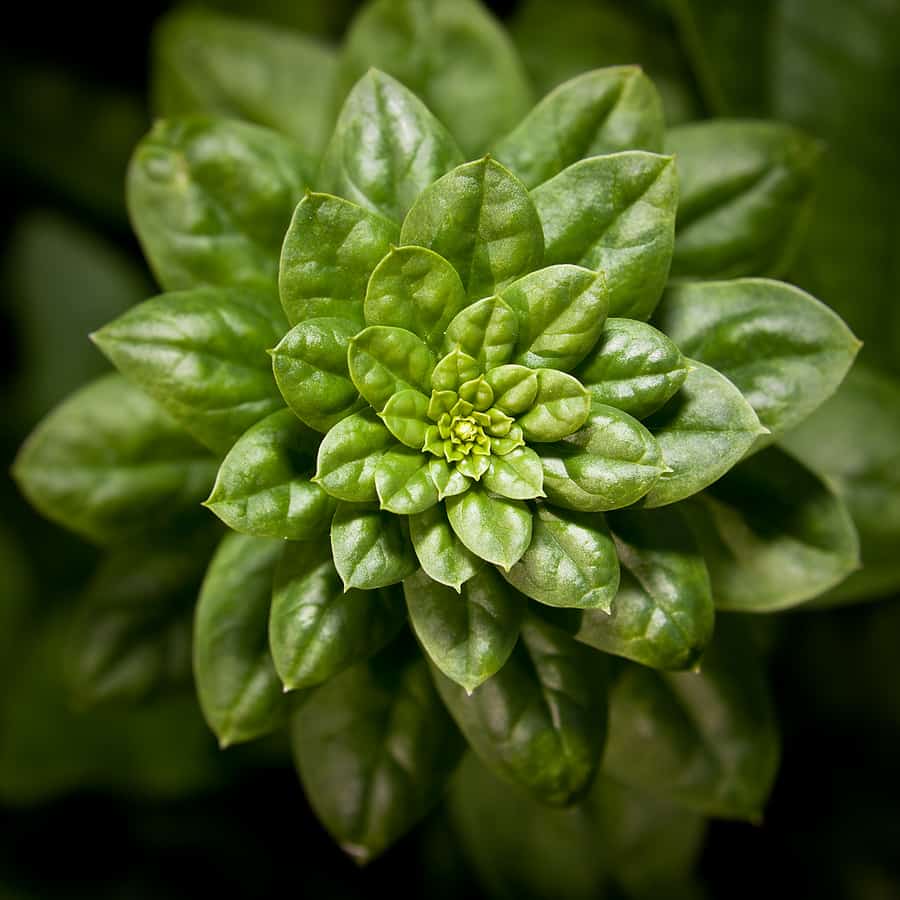
Saving spinach seeds
- Spinach is a wind-pollinated, self-fertile annual.
- Spinach will not cross with New Zealand spinach, but other spinach varieties will cross when the fine pollen is carried by the wind.
- Plant spinach varieties apart to avoid cross-pollination or do not allow plants to flower.
- Save seeds from late-bolting plants that are good-sized and abundantly leafy.
- When green leaves turn yellow, pull up the plant and hand-strip seed stalks.
- Spinach seeds will remain viable for about 5 years.
Spinach varieties to grow
Smooth-leaf spinach varieties. Choose ‘Olympia’ which grows well in cool weather. ‘Nordic’ grows well in cold weather.
Semi-savoy spinach varieties. Try ‘Tyee’, ‘Space’, and ‘Melody’.
Savoyed spinach varieties. Choose ‘Winter Bloomsdale’ for autumn and winter growing.
- Winter spinach varieties include ‘Bloomsdale Longstanding,’ and ‘Cold Resistant Savoy.’
- A good fall variety is ‘Tyee’ which is mildew resistant. ‘Melody’ has smooth, dark green leaves and does not turn bitter tasting.
- ‘Avon’ is semi-puckered leaves and has good heat tolerance; puckered leaves are nutritious.
- Smooth-leaved varieties are more tender and easier to clean off dirt and grit for eating raw in salads.
- Varieties with savoy leaves are generally more heat-tolerant and disease resistant.
- ‘America’ (52 days): crumpled, dark green glossy leaves; mostly heat and drought-tolerant.
- ‘Bloomsdale Long Standing’ (43 days): thick crinkled, dark green, glossy leaves; slow to bolt; mosaic virus tolerant.
- ‘Giant Noble’ (45 days): smooth flat leaves; leaves are large, thick, and pointed; resistant to mosaic virus.
- ‘King of Denmark’ (46 days): rounded, slightly crumpled, dark green leaves; hardy plant.
- ‘Melody’ (42 days) large plant with semi-crinkled leaves; resistant to mosaic and powdery mildew.
- ‘Tyee’ (37-53 days): resistant to downy mildew.
Hot weather spinach alternatives
Malabar spinach (Basella alba ‘Rubra’) is heat- and drought-tolerant. New Zealand spinach (Tetragonia expansa) is heat-tolerant.
- Malabar spinach: vigorous climbing vines; native to tropical Asia and Africa.
- New Zealand spinach: grows naturally as a trailing ground cover.
Spinach frequently asked questions
Q: What causes small white cottony blotches on the upper surfaces of spinach leaves (there are usually yellow spots on the undersides)?
A: This is called white rust, a fungus disease that can be controlled with an organic fungicide. Also, avoid overhead watering which can spread disease.
Q; What causes spinach to become stunted with yellow leaves and twisted leaves and stems?
A: This is caused by a disease called spinach blight or spinach yellow, which is spread by aphids. Grow resistant varieties (check seed packets) and control aphids as soon as they appear.
Q: What causes spinach to flower before it is ready to harvest?
A: Long days and warm summer temperatures force spinach to flower prematurely. Plant earlier in the spring or in fall, when days are shorter and cooler.
About spinach
- Spinach is a cool-season annual grown for its leaves.
- Spinach forms a rosette of dark green leaves that can be flat or crinkled (savoy leaf spinach).
- Spinach is related to beets and Swiss chard of the amaranth family.
- Botanical name: Spinacia oleracea
- Family: Amaranthaceae
- Origin: Asia
Spinach articles on Harvest to Table:
How to Harvest and Store Spinach
Spinach Growing Problems: Troubleshooting
Six Ways to Cook and Serve Spinach
How to Grow New Zealand Spinach
Grow 80 vegetables: THE KITCHEN GARDEN GROWERS’ GUIDE
Garden Planning Books at Amazon:
- Vegetable Garden Grower’s Guide
- Tomato Grower’s Answer Book
- Vegetable Garden Almanac & Planner
- Kitchen Garden Grower’s Guide Vegetable Encyclopedia
More how to grow articles:
Learn how to plant, grow, and harvest your favorite vegetables. Click below for all you need to know.
- Artichoke
- Arugula
- Asparagus
- Beans, Snap
- Beets
- Broad Beans
- Broccoli
- Brussels Sprouts
- Cabbage
- Cantaloupe — Melons
- Cardoon
- Carrots
- Cauliflower
- Celeriac
- Celery
- Chard
- Chayote Squash
- Chickpeas
- Chicory
- Chinese Cabbage
- Collards
- Corn Salad
- Corn, Sweet
- Cresses
- Cucumbers
- Eggplant
- Endive and Escarole
- Fava Beans
- Florence Fennel
- Garbanzo Beans
- Garlic
- Horseradish
- Jerusalem Artichoke
- Kale
- Kohlrabi
- Leeks
- Lettuce
- Lima Beans
- Melons
- Mizuna
- Mustard Greens
- New Zealand Spinach
- Okra
- Onions
- Parsnips
- Peanuts
- Peas
- Peppers
- Potatoes
- Pumpkins
- Radicchio
- Radishes
- Rhubarb
- Rutabaga
- Salsify
- Shallots
- Sorrel
- Southern Peas
- Soybeans
- Spinach
- Squash, Summer
- Squash, Winter
- Sunchokes
- Sweet Potato
- Swiss Chard
- Taro
- Tomatillo
- Tomatoes
- Turnips
- Watermelon
- Zucchini















